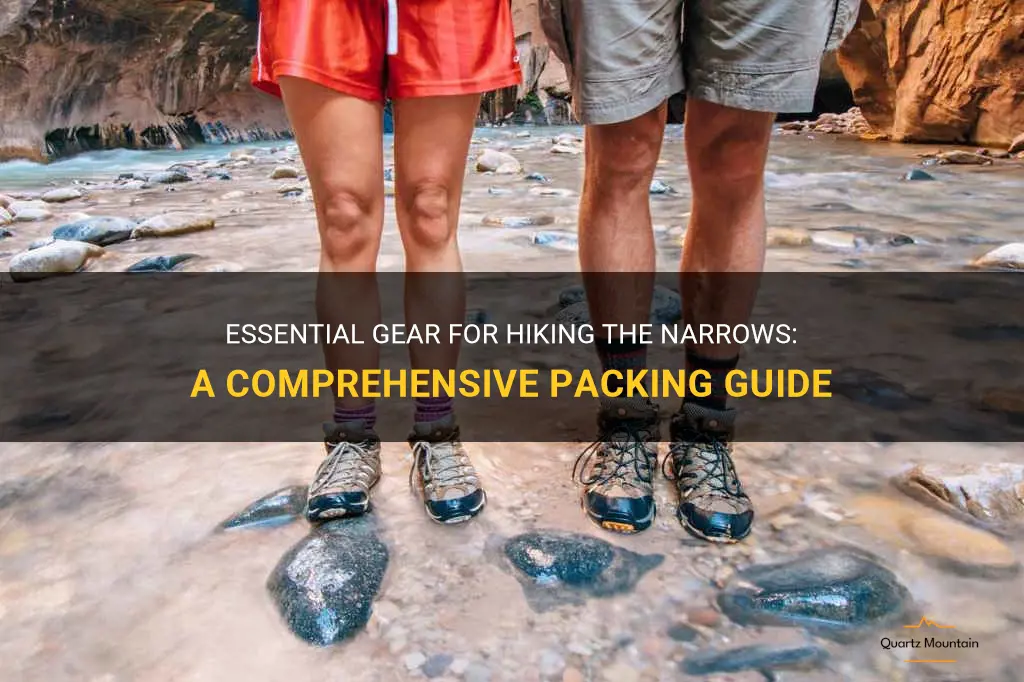
The Narrows, a breathtaking slot canyon located in Zion National Park, is a must-see destination for hiking enthusiasts. With its twisting walls and crystal-clear waters, it offers a memorable and awe-inspiring adventure. However, before embarking on this challenging and exhilarating hike, it is crucial to be well-prepared with the essential gear. In this comprehensive packing guide, we will cover everything you need to ensure a safe and successful expedition through the Narrows. From sturdy shoes to proper hydration and navigation tools, we've got you covered, so let's dive in and get ready for an unforgettable hiking experience in the Narrows.
| Characteristic | Value |
|---|---|
| Weather | Variable and unpredictable |
| Footwear | Sturdy hiking boots or water shoes |
| Clothing | Quick-drying, moisture-wicking layers |
| Backpack | Lightweight and waterproof |
| First Aid Kit | Basic supplies like bandages, painkillers, and blister treatment |
| Water | At least 1 gallon per person per day |
| Food | High-energy snacks and meals |
| Navigation | Map, compass, and/or GPS |
| Sun Protection | Sunscreen, hat, sunglasses |
| Lighting | Headlamp or flashlight |
| Shelter | Lightweight rain gear or tarp |
| Tools | Pocket knife, multi-tool |
| Hygiene | Toilet paper, hand sanitizer |
| Communication | Cell phone and/or satellite phone |
| Emergency | Whistle, mirror, emergency blanket |
| Bug protection | Insect repellent |
| Rope | For rappelling or crossing water |
| Extra clothing | Warm layers for cold weather |
| Water filtration | Filter or purification tablets |
| Cash/ID | In case of emergency |
| Camera | Optional, for capturing memories |
What You'll Learn
- What essential clothing and footwear should I pack when hiking the Narrows?
- What type of backpack should I use and what items should I include to ensure a comfortable and successful hike?
- Is there any specific gear I need to bring in order to safely navigate the water and currents while hiking the Narrows?
- Are there any recommended safety items or emergency supplies that I should pack for the hike?
- What food and water should I bring with me on the hike and how much should I plan for?

What essential clothing and footwear should I pack when hiking the Narrows?
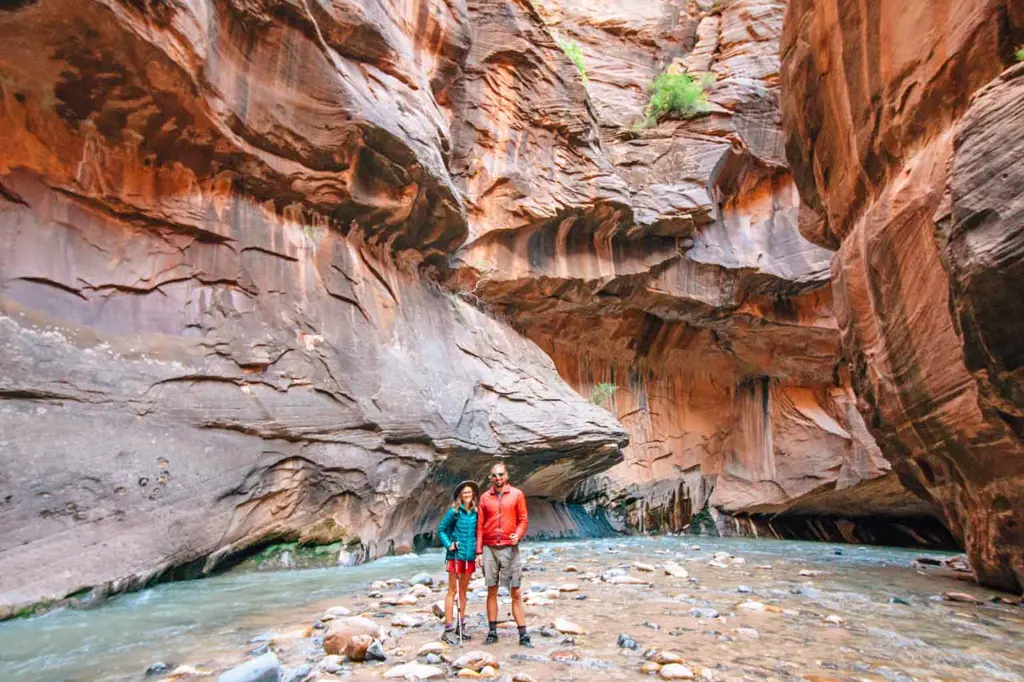
When planning a hiking trip to the Narrows, it is crucial to pack the right clothing and footwear to ensure comfort and safety. The Narrows is a unique hiking trail located in Zion National Park, Utah, where you hike through a narrow slot canyon along the Virgin River. In this article, we will discuss the essential clothing and footwear you should pack to have a successful and enjoyable hiking experience in the Narrows.
Protective Clothing:
When hiking the Narrows, it is essential to wear clothing that will protect you from the elements and potential hazards. Here are some key items to consider:
A. Wetsuit or Drysuit:
Since most of the hike is in the water, it is recommended to wear a wetsuit or drysuit. These garments provide insulation and protect your body from the cold water. They also offer added buoyancy, which can be beneficial for navigating the river currents. Choose a wetsuit or drysuit appropriate for the water temperature and weather conditions.
B. Quick-Drying Layers:
Wear quick-drying layers made of synthetic materials like nylon or polyester. Avoid cotton as it retains moisture and can make you feel cold and uncomfortable. Opt for a moisture-wicking base layer, a mid-layer for insulation, and a waterproof outer layer to protect against rain and splashes.
C. Sun Protection:
Zion National Park has a high elevation and intense sun exposure, so it is crucial to wear sun protection. Use sunscreen with a high SPF rating, wear a wide-brimmed hat to shield your face, and don't forget to wear sunglasses to protect your eyes from harmful UV rays.
Footwear:
Proper footwear is essential when hiking in the Narrows due to the slippery river rocks and uneven terrain. Here's what you should consider:
A. Hiking Boots:
Invest in a good pair of hiking boots that provide ankle support and have a sturdy sole for traction. Look for boots that are waterproof or have water-resistant features, as your feet will get wet during the hike.
B. Neoprene Socks:
Wearing neoprene socks is highly recommended as they offer insulation and protection for your feet in the cold water. They also help prevent blisters and provide additional grip on slippery surfaces.
C. Trekking Poles:
Trekking poles can provide stability and help with balance while navigating the river currents. They also help reduce the strain on your legs, especially when walking on uneven and slippery terrain. Look for lightweight and collapsible poles that can easily be stored when not in use.
In addition to clothing and footwear, it is crucial to pack essentials such as extra clothing, food, water, a first aid kit, and a backpack to carry your belongings. It's also essential to check the weather forecast and river conditions before your hike and adjust your clothing accordingly.
Remember, hiking the Narrows can be challenging and conditions can change rapidly. Always prioritize safety and be prepared for any situation. By packing the right clothing and footwear, you'll enhance your hiking experience in the Narrows and enjoy the stunning beauty of Zion National Park to the fullest.
Essential Items for Your Car Camping Checklist
You may want to see also

What type of backpack should I use and what items should I include to ensure a comfortable and successful hike?
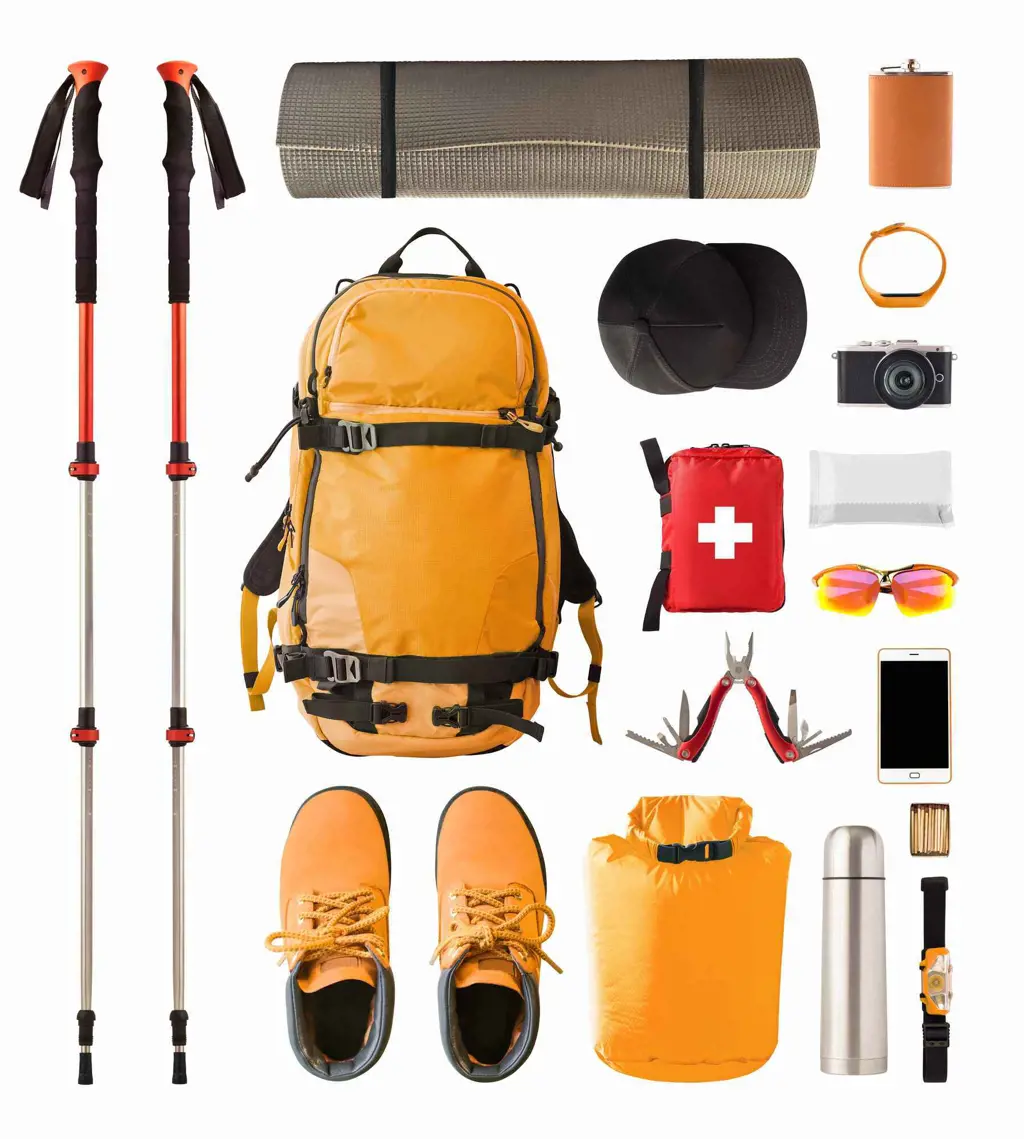
When planning for a hike, it is crucial to choose the right type of backpack and pack essential items to ensure a comfortable and successful experience. The backpack you choose should provide the necessary support and be comfortable to carry for long periods. Additionally, packing the right items will ensure you have everything you need while keeping the weight manageable. This article will provide a step-by-step guide on selecting a suitable backpack and packing it with the essential items for your hike.
Step 1: Choosing the Backpack
The first step is to consider the type of hike you will be undertaking. If you are going on a day hike, a smaller backpack with a capacity of around 20-30 liters should suffice. For longer hikes or overnight trips, opt for a backpack with a capacity of 40-60 liters to accommodate your gear and supplies. Look for backpacks with adjustable shoulder straps, padded hip belts, and a back panel with proper ventilation to ensure comfort during your hike.
Step 2: Organizing the Backpack
Once you have chosen the backpack, it is essential to pack your items in an organized manner. Start by placing heavier items, such as a tent or camping stove, closer to the back of the backpack. This helps maintain balance and keeps the weight centered. Next, pack lighter items, like clothes or food, towards the top and sides of the bag. Use compartments and pockets to separate different items and keep them easily accessible. This organization will make it easier to locate specific items when you need them.
Step 3: Essential Items for Hiking
Now that you know how to organize your backpack, let's take a look at the essential items you should pack for a hike:
- Navigation tools: Carry a map, compass, and GPS device to help you navigate your way through the hike. Familiarize yourself with the route beforehand to avoid getting lost.
- Sun protection: Protect yourself from harmful UV rays by carrying sunscreen, sunglasses, and a hat. Additionally, pack a lightweight, long-sleeved shirt to shield your skin from the sun.
- Extra clothing: Always pack an extra set of clothing, including socks and underwear. These can come in handy if you encounter unexpected changes in weather or get wet.
- Water and food: Carry an adequate amount of water to stay hydrated throughout the hike. If your hike is longer or in a remote area, consider investing in a water filtration system. Pack lightweight, high-energy snacks and meals that are easy to prepare.
- First aid kit: A well-stocked first aid kit is essential for any hike. Include items like bandages, antiseptic wipes, pain relievers, insect repellent, and any personal medication you may require.
- Lighting: Carry a headlamp or flashlight with extra batteries. This will ensure you have enough light in case you end up hiking during low-light conditions or need to set up camp at night.
- Emergency shelter: Pack a lightweight emergency shelter like a bivvy sack or emergency blanket. This will provide protection in case you are caught in unfavorable weather conditions or need to spend an unexpected night outdoors.
- Multi-tool: A versatile multi-tool, such as a Swiss Army knife, can come in handy for various tasks during your hike, such as fixing gear or preparing food.
Remember, these items are just the essentials. Depending on the length and difficulty of your hike, you may need to adjust the items and quantities accordingly.
In conclusion, selecting the right backpack and packing essential items are crucial for a comfortable and successful hiking experience. Choose a backpack that provides support and comfort, and pack the necessary items in an organized manner. Make sure to include navigation tools, sun protection, extra clothing, water and food, a first aid kit, lighting, emergency shelter, and a multi-tool. By following these steps and considering your specific hiking needs, you can ensure a safe and enjoyable hiking adventure.
Essential Items to Pack for an Epic 19-Day Journey Out West
You may want to see also

Is there any specific gear I need to bring in order to safely navigate the water and currents while hiking the Narrows?
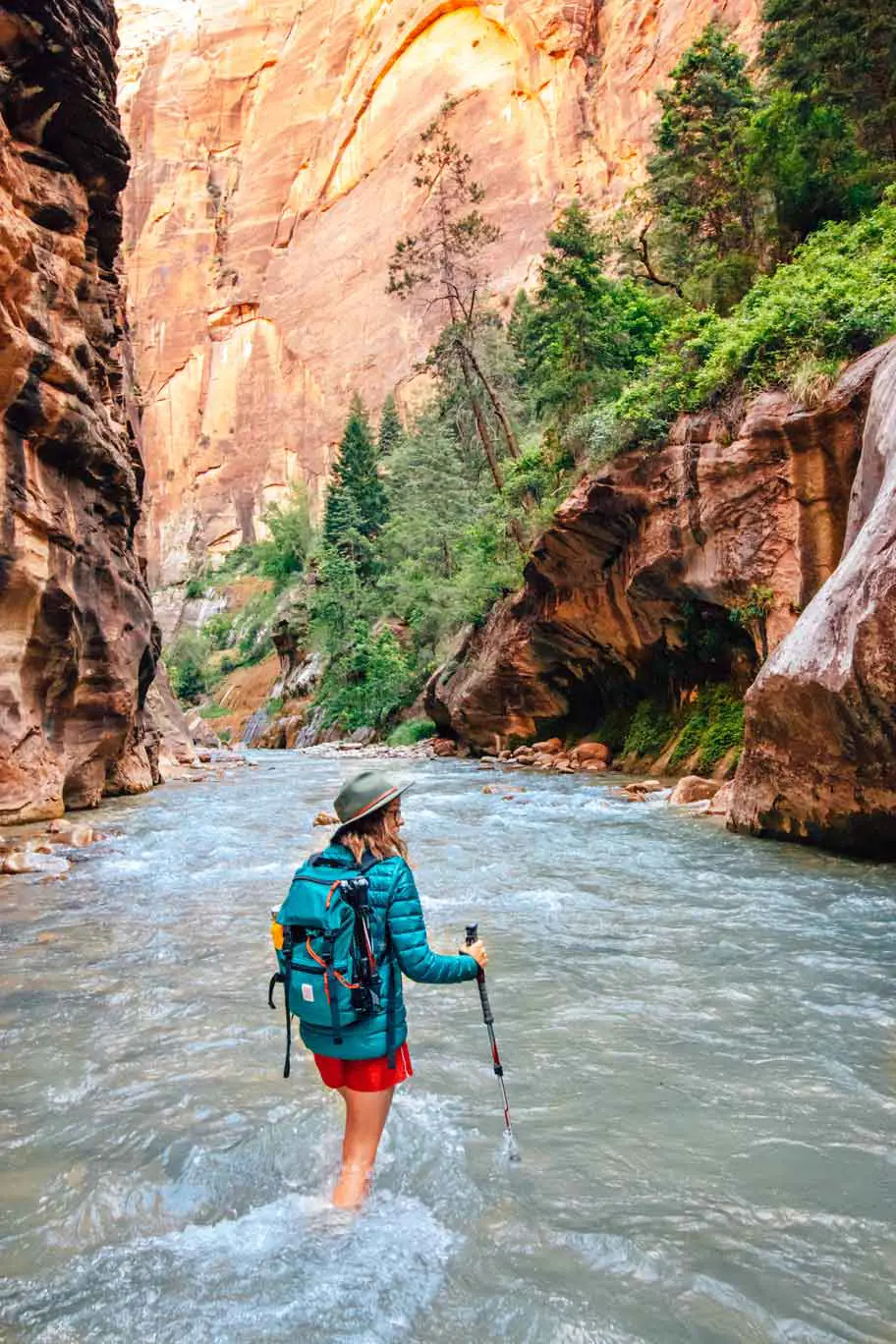
When hiking the Narrows in Zion National Park, it is essential to have the right gear to safely navigate the water and currents. The Narrows hike is a unique experience that takes you deep into a slot canyon, where you will be walking through the Virgin River. Here are some specific gear recommendations to ensure a safe and enjoyable hiking experience in the Narrows.
- Footwear: The most crucial gear you will need is proper footwear. It is recommended to rent or purchase a pair of canyoneering shoes or neoprene socks. These specialized shoes provide excellent traction on the slippery river rocks and protect your feet from getting wet and cold. Regular hiking boots are not recommended as they can become heavy and uncomfortable when wet.
- Walking Stick: The Narrows hike involves walking on uneven river rocks, and a walking stick can provide stability and help you maintain balance. It is advisable to use a hiking pole or rent a sturdy walking stick from the park's visitor center. This will greatly reduce the risk of slipping and falling in the water.
- Dry Bags: Since you will be hiking in the water for a significant portion of the Narrows trail, it is crucial to protect your belongings. Carry dry bags to keep your electronics, extra clothes, and snacks dry. It is also recommended to carry a waterproof phone case or a waterproof pouch for your phone.
- Wetsuit or Drysuit (optional): If you plan to hike the Narrows in colder months or during early spring when the water temperature is low, a wetsuit or drysuit can provide additional insulation against the cold water. This is especially important as prolonged exposure to cold water can lead to hypothermia.
- Water Shoes or Sandals: While canyoneering shoes are the ideal choice for hiking the Narrows, water shoes or sandals with good traction can also work well. Choose a pair that fits securely on your feet and provides ample support as you walk on the river rocks.
- Extra Clothing Layers: Depending on the weather and time of year, it is advisable to dress in layers. Wearing quick-drying, moisture-wicking fabrics will help keep you comfortable during the hike. Carry extra layers such as a lightweight, waterproof jacket or a fleece sweater in case the weather changes unexpectedly.
- Trekking Poles: In addition to a walking stick, trekking poles can provide further stability and support while hiking in the water. They can help you navigate through deeper sections of the river and maintain a steady balance on slippery rocks.
It is crucial to check the weather and water conditions before embarking on the Narrows hike. The water flow can vary greatly depending on the time of year, and flash floods can occur, making the hike dangerous or even impossible. It is advisable to consult with the park rangers for up-to-date information and safety recommendations.
Remember to always prioritize safety while hiking the Narrows. Having the right gear and being prepared for the conditions will ensure a safe and enjoyable experience in one of the most stunning and unique landscapes in the world.
Essential Items to Pack for a Memorable Trip to Ethiopia
You may want to see also

Are there any recommended safety items or emergency supplies that I should pack for the hike?
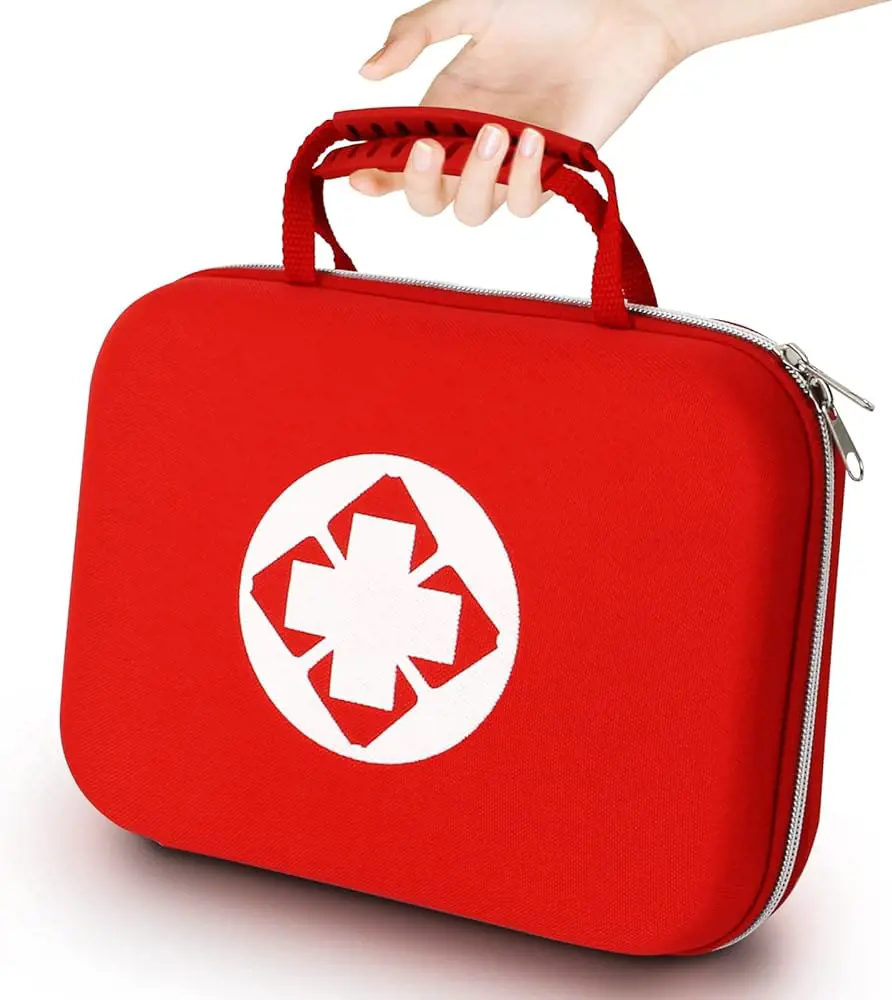
When going on a hike, it is important to be prepared for any potential safety issues or emergency situations that may arise. Packing the right safety items and emergency supplies can make a big difference in how well you are able to handle unexpected incidents. Below are some recommended items that you should consider including in your hiking gear:
- First Aid Kit: This is perhaps the most important safety item to carry on any hike. A well-stocked first aid kit should include essentials such as bandages, antiseptic wipes, adhesive tape, pain relievers, and any prescription medications that you may require. It is also a good idea to carry a basic manual on wilderness first aid, in case you need to tend to more serious injuries in the field.
- Navigation Tools: Getting lost is a common occurrence while hiking, especially if you are exploring unfamiliar terrain. To avoid this, always carry a map and compass, and make sure you know how to use them. In addition, a GPS device or a smartphone with a navigation app can be a handy backup. It is also recommended to pack a whistle or a signal mirror, which can help rescuers locate you in case of an emergency.
- Extra Clothing and Rain Gear: Weather conditions can change rapidly in the outdoors, and being unprepared for rain or cold temperatures can be dangerous. Pack an extra set of warm clothing, including a hat and gloves, as well as a waterproof jacket or poncho. Even if the weather forecast is clear, it is always better to be safe than sorry.
- Food and Water: Dehydration and starvation are serious risks on long hikes, so it is important to carry enough food and water to sustain yourself. Pack lightweight, high-energy snacks such as trail mix, energy bars, and dried fruits. Also, make sure to carry a sufficient amount of water or a water purification system, as clean drinking water may not always be readily available along the trail.
- Emergency Shelter: Even if you plan on hiking during the day, it is wise to carry some form of emergency shelter, such as a lightweight tent or a bivvy bag. This can provide protection in case you get stranded or injured and need to spend the night outdoors. A space blanket or an emergency thermal blanket can also be useful for staying warm in cold conditions.
- Personal Protective Equipment: Depending on your hiking destination, it may be necessary to include additional safety items such as sunscreen, insect repellent, and a hat with a wide brim to protect against sunburn and bug bites. If you are planning a hike in a rocky or uneven terrain, consider wearing a sturdy pair of hiking boots for ankle support.
Remember, the specific safety items and emergency supplies you pack may differ depending on the length and difficulty of your hike, as well as the area you are exploring. Always research the trail beforehand and consult with experienced hikers or park authorities to ensure you have the necessary gear for a safe and enjoyable hike.
Moving to Vietnam: Essential Items to Pack
You may want to see also

What food and water should I bring with me on the hike and how much should I plan for?
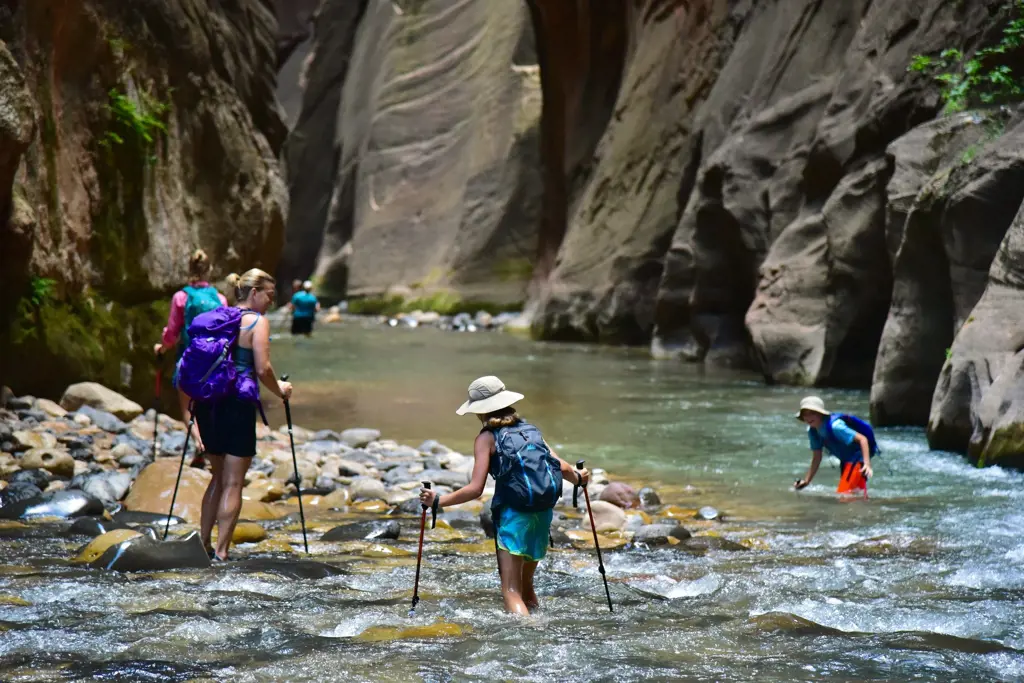
When going on a hike, it is essential to bring enough food and water to keep you fueled and hydrated throughout the journey. The amount of food and water you should plan for depends on various factors such as the length and intensity of the hike, weather conditions, and your individual needs. This article will provide you with some guidelines to ensure you pack the right amount of food and water for your hike.
Before diving into the specifics, it is important to note that water should always be your top priority when planning for a hike. Dehydration can lead to fatigue, dizziness, and even more serious health problems. As a general rule of thumb, aim to drink at least half a liter (16 ounces) of water per hour during physical activity. If you're hiking in hot weather or at high altitudes, you may need to drink even more.
When it comes to food, it is crucial to bring snacks that are lightweight, nutrient-dense, and easy to eat on the go. Opt for foods that are high in carbohydrates to provide you with a steady source of energy. Some great options include granola bars, trail mix, dried fruit, and energy gels. These foods are packed with calories and essential nutrients to fuel your body during the hike.
To determine the quantity of food and water to pack, consider the duration of your hike. As a general guideline, plan for one liter (32 ounces) of water per every two hours of hiking. This estimation may vary depending on the weather and your individual needs. For longer hikes, it is a good idea to bring a water filter or purification tablets in case you come across natural water sources.
Calculating the amount of food to pack is a bit trickier. Aim for around 200-300 calories per hour of moderate to intense hiking activity. This can be adjusted based on your individual metabolism and the difficulty of the trail. On average, a full day of hiking may require anywhere from 2,000 to 4,000 calories. It is always better to pack a little extra food to ensure you have enough energy to sustain you throughout the hike.
In addition to food and water, it is wise to pack some electrolyte drinks or sports beverages to replenish any lost salts and minerals during the hike. These can help prevent cramps and keep your electrolyte levels balanced.
Remember to pack your food and water in sturdy, leak-proof containers that are easy to carry in your backpack. It is also essential to stay mindful of waste management while on the trail. Pack out any food wrappers or containers to leave the environment clean and undisturbed.
In conclusion, bringing enough food and water is crucial for a successful and safe hiking experience. Plan ahead and consider factors such as the duration of your hike, weather conditions, and your individual needs. Stay hydrated, pack nutrient-dense snacks, and fuel your body with the right amount of calories to keep you energized throughout the journey. Happy hiking!
Essential Items to Pack for a Memorable Float Trip Adventure
You may want to see also
Frequently asked questions
For hiking the Narrows, it is important to pack clothing that will keep you comfortable and safe in the water. It is recommended to wear a wetsuit or a drysuit, along with neoprene socks and sturdy hiking boots. Additionally, pack lightweight, quick-drying layers such as a moisture-wicking base layer, a warm insulating layer, and a waterproof outer layer. Don't forget a hat, sunglasses, and sunscreen for sun protection.
When hiking the Narrows, it is essential to bring the right gear to ensure a safe and enjoyable experience. Some key items to pack include a sturdy backpack, a waterproof dry bag to protect your belongings, a walking stick or trekking poles for stability, and a headlamp or flashlight for navigating in low-light conditions. Additionally, bring a first aid kit, a map and compass or GPS device, and plenty of water and snacks for the hike.
Choosing the right footwear is crucial when hiking the Narrows. You will be walking through water for most of the hike, so it is recommended to wear sturdy, closed-toe hiking boots with good ankle support. Look for boots that are waterproof or water-resistant to keep your feet dry and comfortable. It's also a good idea to wear neoprene socks or thick wool socks to prevent blisters and keep your feet warm in the cold water.
When packing your backpack for hiking the Narrows, make sure to include some essential items. These include a water filtration system or water purification tablets to ensure you have access to clean drinking water, extra food and snacks, a multi-tool or knife, a fully charged cell phone or portable charger, and a lightweight emergency shelter such as a tarp or emergency bivvy. Don't forget to pack a whistle and a signaling device in case of emergencies.
When hiking the Narrows in different seasons, you may need to adjust what you pack accordingly. In colder months, it is important to pack extra layers, warmer clothing, and additional insulation to stay warm in the freezing water. In warmer months, pack lighter, breathable clothing and consider wearing a brimmed hat and lightweight long-sleeve shirt to protect yourself from the sun. Always check the weather forecast and trail conditions before your hike and pack accordingly.







